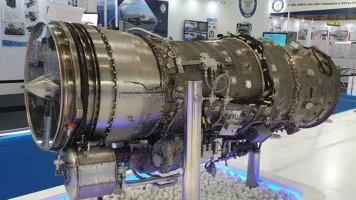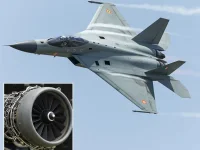- Views: 2K
- Replies: 28
State-owned aerospace and defence company Hindustan Aeronautics Limited (HAL) has officially launched its search for a suitable jet engine to power its developmental supersonic trainer, the Hindustan Lead-in Fighter Trainer (HLFT-42).
HAL issued a Request for Information (RFI) on March 17, 2025, outlining the core requirements for the powerplant. The document specifies the need for an engine capable of producing a maximum thrust between 95 and 100 kilonewtons (kN) and possessing a substantial total technical lifespan of 6,000 hours. This step underscores HAL's commitment to equipping the advanced trainer with a robust engine suited for modern pilot training needs.
First unveiled as a scale model at the Aero India airshow in Bengaluru in 2023, the HLFT-42 is envisioned as a critical link in pilot training. It aims to transition pilots from basic trainers to advanced, high-performance combat aircraft currently entering or planned for service with the Indian Air Force (IAF), such as the Tejas Mk2 and the future Advanced Medium Combat Aircraft (AMCA).
Conceptual work on the HLFT-42 began back in 2017. The aircraft features a single-engine design with traditional swept wings and will incorporate modern avionics, including an Active Electronically Scanned Array (AESA) radar, an Infrared Search and Track (IRST) system for passive targeting, and a sophisticated Fly-by-Wire (FBW) control system for enhanced maneuverability and safety.
According to details shared by industry observers, the engine performance is critical for the aircraft to achieve its design goals, including reaching a maximum speed of Mach 1.8 (1.8 times the speed of sound) and operating at high altitudes up to 18 kilometres (around 60,000 feet).
These specifications are important as the HLFT-42 is reportedly intended to replace the IAF's existing fleet of BAE Systems Hawk 132 subsonic advanced jet trainers.
This reflects a strategic shift towards utilizing supersonic trainers that can more accurately replicate the conditions and complexities of modern air combat scenarios for trainee pilots.
The required thrust range of 95-100 kN (approximately 21,000-22,500 pounds of force) will ensure the HLFT-42 has the necessary power for high-speed flight profiles while maintaining stability during lower-speed training exercises. This performance level surpasses many current trainer aircraft, like the BAE Hawk (max speed Mach 1.2), and aligns it with advanced contemporaries such as South Korea's KAI T-50 Golden Eagle (max speed Mach 1.5).
Furthermore, designed with a maximum take-off weight (MTOW) of 16.5 tonnes and equipped with 11 hardpoints for carrying ordnance, the HLFT-42 offers potential secondary capabilities as a light combat aircraft, capable of deploying weapons like the indigenous Astra beyond-visual-range missile and ASRAAM close-combat missiles.
The RFI issued by HAL seeks extensive data from potential engine manufacturers, covering aspects like engine design philosophy, detailed performance metrics, maintenance procedures, reliability data, and projected lifecycle costs. This information-gathering phase is widely seen as a precursor to a formal Request for Proposals (RFP), which would initiate a competitive procurement process or potentially lead to a strategic partnership.
Potential respondents to the RFI could include international engine manufacturers already supplying engines for Indian defence programs, such as GE Aviation (whose F404 powers the Tejas Mk1/1A and whose F414 is selected for Tejas Mk2 and AMCA), or other global players with engines in the required thrust class.
The data collected will play a vital role in shaping the final selection and procurement strategy for this crucial component of India's next-generation trainer aircraft.


